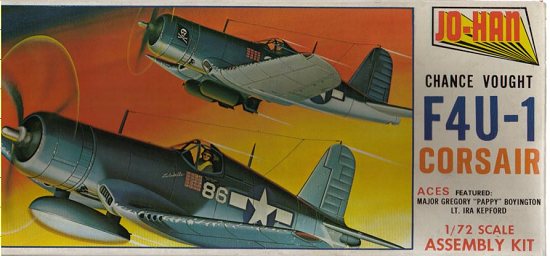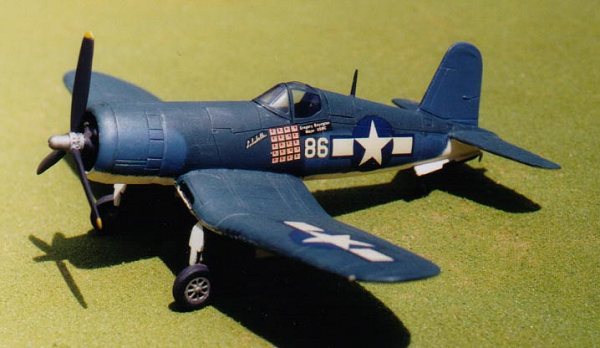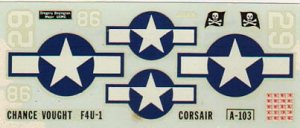
|
KIT: |
JoHan 1/72 F4U-1 Corsair |
|
KIT # |
A-103 |
|
PRICE: |
$ cheap |
|
DECALS: |
Two aircraft |
|
REVIEW & |
Steve Mesner |
|
NOTES: |
` |

|
THE KIT |

Jo-Han is--or was--noted primarily as a model car and promo maker, but back in
the
1970s, they tried their hand at a series of six 1/72 model airplane kits. For a
first effort into a new field, these kits were surprisingly good. All featured
options to build two different airplanes. Some, such as the Corsair reviewed
here, accomplished this only with decals. Others were more ambitious. The P-47
could be built as a bubbletop or razorback, while the A6M Zero could also be
finished as a floatplane Rufe!
 The Jo-Han Corsairís options were decals to build the mounts of aces Ira Kepford
or
Gregory Boyington (the semi-fictitious #86 ďLulubelle,Ē which was not Boyingtonís
ďpersonalĒ airplane), but herein lies a small problem. The Kepford and Boyington
Corsairs
were F4U-1As, whereas the Jo-Han kit, with its wing center section pylons and
underwing
5-inch HVARs, is clearly an F4U-1D.
The Jo-Han Corsairís options were decals to build the mounts of aces Ira Kepford
or
Gregory Boyington (the semi-fictitious #86 ďLulubelle,Ē which was not Boyingtonís
ďpersonalĒ airplane), but herein lies a small problem. The Kepford and Boyington
Corsairs
were F4U-1As, whereas the Jo-Han kit, with its wing center section pylons and
underwing
5-inch HVARs, is clearly an F4U-1D.
Just to confuse matters a bit more, the kitís canopy has the two horizontal
overhead
frames, which means that if itís an F4U-1D, itís an early one! This means to
build an
accurate model from the kit, you have three choices:
1. Build it from the box as an early F4U-1D.
2. Remove the underwing pylons and leave off the rockets and build it as an
F4U-1A.
3. Remove the canopy overhead frames (or replace the canopy with Squadron
vac
glass for the Hasegawa F4U-1D) and build it as a ďnormalĒ F4U-1D.
Now that we have that out of the way, the rest of the kit is quite nice. Shape
is excellent,
and assembly is almost literally a snap. Panel lines are engraved--deeply
engraved in a
manner reminiscent of the Matchbox ďmad trencher,Ē but those can be toned down
with
the application of a coat or two of easily sanded common office Wite-Out. A
minor disappointment is the rudder--it's quite featureless, no hint of ribbing
or structure.
Thereís a pretty decent engine and prop, and the landing gear and wheels arenít
bad
either. Wheel well detailing is nonexistent, as is a cockpit, and Iím not
kidding. Thereís a
pilotís seat, and thatís it inside. I donít think Iíve ever seen a kit that
cried out more for an
inexpensive True Details cockpit to be added. A neat little clear plastic stand
for flying
display is included.
Decals, as mentioned earlier, are for Kepfordís #29 of VF-17 and #86 of VMF-214,
often
incorrectly attributed to Boyington. Ordnance comprises 5Ē HVARs, a pair of
bombs for
the wing center section pylons, and the big centerline belly fuel tank often seen
on both
F4U-1As and -1Ds.
All things considered, this is a nifty little kit, ranking behind only the
Tamiya and
Hasegawa offerings in this scale, way ahead of the Revell, Airfix, and Hawk/Testor,
and
roughly on a par with the Heller. (The Heller looks a bit more detailed when
finished, but
is a good deal harder to build and not quite as accurate in shape.) I built the
example
shown around 1977, right out of college and before I got my airbrush up and
running; the
paint is hand-brushed Humbrol, over which I directly applied the kit decals (no
gloss or
flat coats). Weathering was done with Rub-N-Buff, dry-brushing it on with a very
stiff
brush. After all these years, the model still looks pretty good to me--from two
or three
feet away, anyway! I recently acquired another copy of the kit and am looking
forward to
building it ďsometimeĒ in the future.
If Iím not mistaken, Jo-Han turned out one last limited run of some of their
airplane kits a
couple of years ago. I donít know if the Corsair was reissued, but they turn up
with some
frequency on eBay, usually selling for between $3 and $8. Thatís a most
reasonable price,
but keep in mind with eBay that youíre also fighting shipping charges that seem
to start at
about $4 these days. Best bet is to buy one being offered in conjunction with
another kit
(Iíve often seen them sold in a ďsetĒ with the Jo-Han Zero/Rufe) to amortize the
shipping
over two or more kits. At any rate, if youíre a builder and not a collector,
donít pay more
for one than youíd have to give for the superior Hasegawa Corsair.
It looks like what itís supposed to, goes together easily enough for a kid or
beginner to
build, and has enough accuracy and potential to satisfy even a pretty serious
modeler. That makes the Jo-Han Corsair a pretty darn good little kit in my book.
Grab one and have some fun! Model on!
If you would like your product reviewed fairly and quickly by a site that averages thousands of visits a day, please contact me or see other details in the Note to Contributors.